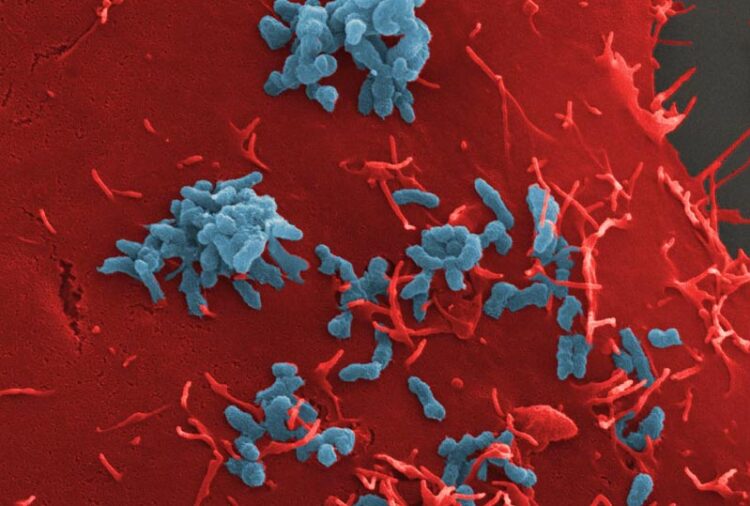How bacteria adhere to cells

Adhesion of Bartonella henselae (blue) to human blood vessel cells (red). The bacterium’s adhesion to the host cells could be blocked with the help of what are known as “anti-ligands”.
Credit: https://www.mdpi.com/2075-4418/11/7/1259
Basis for the development of a new class of antibiotics.
Researchers from University Hospital Frankfurt and Goethe University Frankfurt have unravelled how bacteria adhere to host cells and thus taken the first step towards developing a new class of antibiotics.
The adhesion of bacteria to host cells is always the first and one of the decisivesteps in the development of infectious diseases. The purpose of this adhesion by infectious pathogens is first to colonize the host organism (i.e., the human body), and then to trigger an infection, which in the worst case can end fatally. Precise understanding of the bacteria’s adhesion to host cells is a key to finding therapeutic alternatives that block this critical interaction in the earliest possible stage of an infection.
Critical interaction with the human protein fibronectin
In collaboration with other researchers, scientists from University Hospital Frankfurt and Goethe University Frankfurt have now explained the exact bacterial adhesion mechanism using the human-pathogenic bacterium Bartonella henselae. This pathogen causes “cat-scratch disease”, a disease transmitted from animals to humans. In an international collaborative project led by the Frankfurt research group headed by Professor Volkhard Kempf, the bacterial adhesion mechanism was deciphered with the help of a combination of in-vitro adhesion tests and high-throughput proteomics. Proteomics is the study of all the proteins present in a cell or a complex organism.
The scientists have shed light on a key mechanism: the bacterial adhesion to the host cells can be traced back to the interaction of a certain class of adhesins – called “trimeric autotransporter adhesins” – with fibronectin, a protein often found in human tissue. Adhesins are components on the surface of bacteria which enable the pathogen to adhere to the host’s biological structures. Homologues of the adhesin identified here as critical are also present in many other human-pathogenic bacteria, such as the multi-resistant Acinetobacter baumannii, which the World Health Organization (WHO) has classified as the top priority for research into new antibiotics.
State-of-the-art protein analytics were used to visualize the exact points of interaction between the proteins. In addition, it was possible to show that experimental blocking of these processes almost entirely prevents bacterial adhesion. Therapeutic approaches that aim to prevent bacterial adhesion in this way could represent a promising treatment alternative as a new class of antibiotics (known as “anti-ligands”) in the constantly growing domain of multi-resistant bacteria.
Prestigious funding
The research work was funded as part of an Innovative Training Network (“ViBrANT: Viral and Bacterial Adhesin Network Training”) under the Marie Skłodowska-Curie Actions (MSCA) of the European Union’s HORIZON 2020 research and innovation programme.
The scientific paper has been published in the prestigious journal “Microbiology Spectrum” of the American Society of Microbiology (ASM) and was acknowledged as “Paper of the Month” by the German Society for Hygiene and Microbiology (DGHM) on 18 June 2022.
Picture download:
https://www.kgu.de/fileadmin/redakteure/Presse/Bilder_Pressmitteilungen/2022/Vac…
Caption: First author of the study: Diana Jaqueline Vaca, Institute of Medical Microbiology and Hospital Hygiene at University Hospital Frankfurt. Photo: University Hospital Frankfurt
https://www.kgu.de/fileadmin/redakteure/Presse/Bilder_Pressmitteilungen/2022/Bar…
Adhesion of Bartonella henselae (blue) to human blood vessel cells (red). The bacterium’s adhesion to the host cells could be blocked with the help of what are known as “anti-ligands”.
Credit: https://www.mdpi.com/2075-4418/11/7/1259
Wissenschaftliche Ansprechpartner:
Professor Volkhard A. J. Kempf
Director of the Institute of Medical Microbiology and Hospital Hygiene
University Hospital Frankfurt
Tel.: +49 (0)69 6301–5019
volkhard.kempf@kgu.de
Website: https://www.kgu.de/einrichtungen/institute/zentrum-der-hygiene/medizinische-mikr…
Originalpublikation:
Vaca, D. J., Thibau, A., Leisegang, M. S., Malmström, J., Linke, D., Eble, J. A., Ballhorn, W., Schaller, M., Happonen, L., Kempf, V. A. J.; Interaction of Bartonella henselae with Fibronectin Represents the Molecular Basis for Adhesion to Host Cells; Microbiology Spectrum, 18 April, 2022. https://doi.org/10.1128/spectrum.00598-22
Media Contact
All latest news from the category: Life Sciences and Chemistry
Articles and reports from the Life Sciences and chemistry area deal with applied and basic research into modern biology, chemistry and human medicine.
Valuable information can be found on a range of life sciences fields including bacteriology, biochemistry, bionics, bioinformatics, biophysics, biotechnology, genetics, geobotany, human biology, marine biology, microbiology, molecular biology, cellular biology, zoology, bioinorganic chemistry, microchemistry and environmental chemistry.
Newest articles

High-energy-density aqueous battery based on halogen multi-electron transfer
Traditional non-aqueous lithium-ion batteries have a high energy density, but their safety is compromised due to the flammable organic electrolytes they utilize. Aqueous batteries use water as the solvent for…

First-ever combined heart pump and pig kidney transplant
…gives new hope to patient with terminal illness. Surgeons at NYU Langone Health performed the first-ever combined mechanical heart pump and gene-edited pig kidney transplant surgery in a 54-year-old woman…

Biophysics: Testing how well biomarkers work
LMU researchers have developed a method to determine how reliably target proteins can be labeled using super-resolution fluorescence microscopy. Modern microscopy techniques make it possible to examine the inner workings…





















